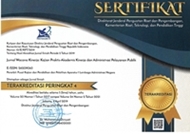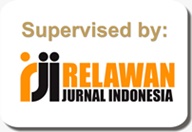Strategi Value Delivery Process pada Pemasaran Digital di Sektor Publik
Abstract
The purpose of this study is to find out how the digital marketing process in public sector organizations is carried out and also to find out how public sector organizations deliver value (value delivery process) through digital marketing processes, especially through social media platforms, and what strategies are most appropriate for public organizations in delivering value. The digital marketing process studied in this study was carried out at the National Civil Apparatus Competency Mapping and Training Center (Puslatbang PKASN) National Institute of Public Administration Republic of Indonesia. To find out the digital marketing process carried out by the Puslatbang PKASN LAN, a social media analysis was carried out using the infact social media analytic application. The results of the analysis found that the digital marketing process through social media has not really been carried out effectively and optimally. This is illustrated by the results the Instagram account @puslatbang_pkasn which shows that the value is 1.04 posts per month and engagement is 0.01, which means it is still low and content is dominated by ceremonial content. Then to determine the most appropriate strategy in carrying out the value delivery process, an analysis was carried out using the analytical hierarchy process (AHP) method. The experts involved in filling out the AHP method amounted to 5 experts who were experts in public sector marketing and social media influencer. The results of the analysis with AHP found that social media platforms in order of priority: Instagram 0.78, Facebook 0.14, and Twitter 0.06. Meanwhile, the best content in delivering value is educational content of 0.48, program info content of 0.20, Q&A content of 0.14 and the rest is quiz content, popular memes and ceremonial content.
Keywords
Full Text:
PDFReferences
Abed, S. S., Dwivedi, Y. K., & Williams, M. D. (2015). Social media as a bridge to e-commerce adoption in SMEs: A systematic literature review. The Marketing Review, 15(1). https://doi.org/10.1362/146934715x14267608178686
Alalwan, A. A., Rana, N. P., Algharabat, R., & Tarhini, A. (2016). A systematic review of extant literature in social media in the marketing perspective. Lecture Notes in Computer Science (Including Subseries Lecture Notes in Artificial Intelligence and Lecture Notes in Bioinformatics), 9844 LNCS. https://doi.org/10.1007/978-3-319-45234-0_8
Amornpashara, N., Rompho, N., & Phadoongsitthi, M. (2015). A study of the relationship between using Instagram and purchase intention. Journal for Global Business Advancement, 8(3). https://doi.org/10.1504/JGBA.2015.071330
Apicella, S., & Streatfeild, N. (2010). Direct, database and digital marketing practice in the government sector: Black hole or parallel universe? Journal of Direct, Data and Digital Marketing Practice, 11(4). https://doi.org/10.1057/dddmp.2009.42
Ayuni, I., Winoto, Y., & Khadijah, U. L. (2022). PERILAKU LITERASI INFORMASI PADA ANAK DI MEDIA SOSIAL. Literasi : Jurnal Bahasa Dan Sastra Indonesia Serta Pembelajarannya, 6(2). https://doi.org/10.25157/literasi.v6i2.7728
Beal, C. (1979). Studying the public’s information needs. Journal of Librarianship and Information Science, 11(2). https://doi.org/10.1177/096100067901100204
Bestsennyy, O., Gilbert, G., Harris, A., & Rost, J. (2021). Telehealth: A quarter-trillion-dollar post-COVID-19 reality? Healthcare Systems & Services, May.
Bhardwaj, D. (2017). The new rules of marketing and PR: How to use social media, online video, mobile applications, blogs, news releases, and viral marketing to reach buyers directly by David Merman Scott . Journal of Information Technology Case and Application Research, 19(3). https://doi.org/10.1080/15228053.2017.1362848
Charlesworth, A. (2014). Digital Marketing: A Practical Approach Second Edition. Routledge.
Cui, T., & Osborne, S. P. (2023). New development: Value destruction in public service delivery—a process model and its implications. Public Money and Management, 43(2). https://doi.org/10.1080/09540962.2022.2126645
Dwivedi, Y. K., Ismagilova, E., Hughes, D. L., Carlson, J., Filieri, R., Jacobson, J., Jain, V., Karjaluoto, H., Kefi, H., Krishen, A. S., Kumar, V., Rahman, M. M., Raman, R., Rauschnabel, P. A., Rowley, J., Salo, J., Tran, G. A., & Wang, Y. (2021). Setting the future of digital and social media marketing research: Perspectives and research propositions. International Journal of Information Management, 59. https://doi.org/10.1016/j.ijinfomgt.2020.102168
Elkin, M. (2007). Spanish TV Ads Seek to Deter Boat People. The Guardian, 20.
Ernayani, R., Daengs GS, A., Tarigan, N. P., Lestari, W., & Timotius, E. (2021). Kajian fenomenologi pemasaran digital agen properti melalui medium instagram. Jurnal Komunikasi Profesional, 5(3). https://doi.org/10.25139/jkp.v5i3.3804
Evans, W. D., Thomas, C. N., Favatas, D., Smyser, J., & Briggs, J. (2019). Digital Segmentation of Priority Populations in Public Health. Health Education and Behavior, 46(2_suppl). https://doi.org/10.1177/1090198119871246
Filo, K., Lock, D., & Karg, A. (2015). Sport and social media research: A review. In Sport Management Review (Vol. 18, Issue 2). https://doi.org/10.1016/j.smr.2014.11.001
Harris, Thomas L, and Whalen, P. T. (2006). The Marketer’s Guide To Public Relations In The 21st Century. Thomson Higher Education.
Kotler, P. (2012). What is Marketing. Https://Www.Kotlermarketing.Com/Phil_questions.Shtml#answer3.
Kotler, P., & Lee, N. (2007). Marketing in the Public Sector: The Final Frontier. The Public Manager, 36(1).
Kotler Philip, Keller Kevin Lane, Brady Mairead, G. M. and H. T. (2016). Marketing Management (3rd Editio). Pearson.
Lal, B., Ismagilova, E., Dwivedi, Y. K., & Kwayu, S. (2020). Return on Investment in Social Media Marketing: Literature Review and Suggestions for Future Research. https://doi.org/10.1007/978-3-030-24374-6_1
Marta, R. F., Fernando, J., & Simanjuntak, R. F. (2019). Eksplikasi Kualitas Konten Peran Keluarga Pada Instagram @Kemenpppa. ETTISAL : Journal of Communication, 4(2). https://doi.org/10.21111/ejoc.v4i2.3702
MOTI. (2005). What is Marketing? Marketing on The Internet. http://iws.ohiolink.edu/moti/homedefinition.html
Pasquier, M., & Villeneuve, J. P. (2017). Marketing management and communications in the public sector. In Marketing Management and Communications in the Public Sector. https://doi.org/10.4324/9781315622309
Peraturan Menteri Pendayagunaan Aparatur Negara dan Reformasi Birokrasi Nomor 83 Tahun 2012 tentang Pemanfaatan Media Sosial, (2012).
Proctor, T. (2007). Public Sector Marketing. In Health Promotion (Issue September).
Rathore, A. K., Ilavarasan, P. V., & Dwivedi, Y. K. (2016). Social media content and product co-creation: an emerging paradigm. Journal of Enterprise Information Management, 29(1). https://doi.org/10.1108/JEIM-06-2015-0047
SAATY., T. (1993). Pengambilan Keputusan Bagi Para Pemimpin, Proses Hirarki Analitik untuk Pengambilan Keputusan dalam Situasi yang Kompleks. Pustaka Binama Pressindo.
Saxena, A., & Khanna, U. (2013). Advertising on Social Network Sites: A Structural Equation Modelling Approach. Vision: The Journal of Business Perspective, 17(1). https://doi.org/10.1177/0972262912469560
Schmidthuber, L., Ingrams, A., & Hilgers, D. (2021). Government Openness and Public Trust: The Mediating Role of Democratic Capacity. Public Administration Review, 81(1). https://doi.org/10.1111/puar.13298
Setiaman, A., Sugiana, D., & Narotama M., J. (2013). MPLEMENTASI KEBIJAKAN KETERBUKAAN INFORMASI PUBLIK (Analisis Kritis Implementasi Kebijakan Keterbukaan Informasi Publik di Pemerintahan Kota Bandung kepada Warga Kota). Jurnal Kajian Komunikasi, 1(2).
Smith, J.T., and Tighe, S. L. (2006). Transportation Research Board, Annual meeting.
Song, C., & Lee, J. (2016). Citizens Use of Social Media in Government, Perceived Transparency, and Trust in Government. Public Performance and Management Review, 39(2). https://doi.org/10.1080/15309576.2015.1108798
Sugiyono. (2019). Memahami Penelitian Kualitatif. CV Alfabeta.
Taylor, D. G., Lewin, J. E., & Strutton, D. (2011). Friends, fans, and followers: Do ads work on social networks? How gender and age shape receptivity. Journal of Advertising Research, 51(1).
Undang Undang Nomor 14 Tahun 2008 tentang Keterbukaan Informasi Publik. (2008).
Walsh, K. (1994). Marketing and Public Sector Management. In European Journal of Marketing (Vol. 28, Issue 3). https://doi.org/10.1108/03090569410057308
Zhu, Y. Q., & Chen, H. G. (2015). Social media and human need satisfaction: Implications for social media marketing. Business Horizons, 58(3). https://doi.org/10.1016/j.bushor.2015.01.006
DOI: http://dx.doi.org/10.31845/jwk.v26i1.787
Refbacks
- There are currently no refbacks.
Copyright (c) 2023 Pupung Puad Hasan

This work is licensed under a Creative Commons Attribution-NonCommercial-ShareAlike 4.0 International License.
JURNAL WACANA KINERJA INDEXED BY:
__________________________________________________________________________________________________________
@2023 Center fo State Civil Apparatus Training and Development and Competency Mapping (Pusat Pelatihan dan Pengembangan dan Pemetaan Kompetensi Aparatur Sipil Negara Lembaga Administrasi Negara - Puslatbang PKASN LAN) Jl. Kiara Payung KM. 4, 7 Jatinangor, Sumedang, Jawa Barat 45366 Telp. (022) 7790048-7790044-7790049-7782041-7782042 Fax. (022) 7790055-7782178; Email: wacanakinerja@yahoo.com; wacanakinerja@gmail.com
Powered by OJS
















